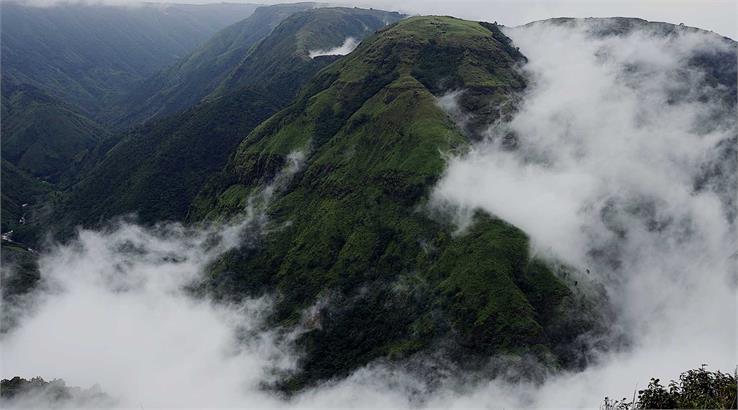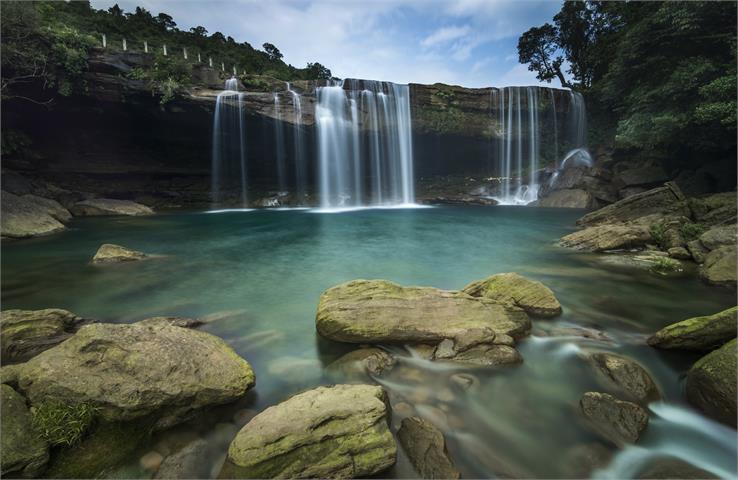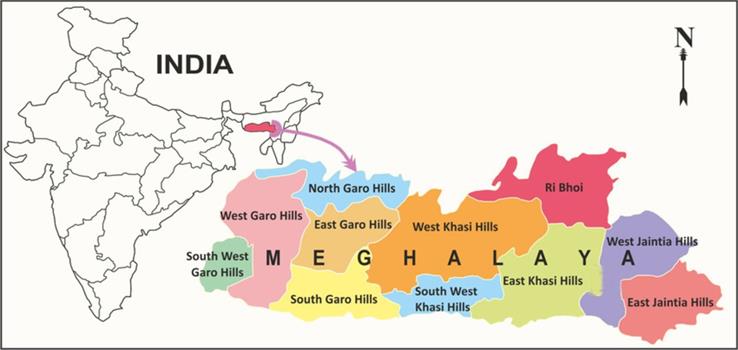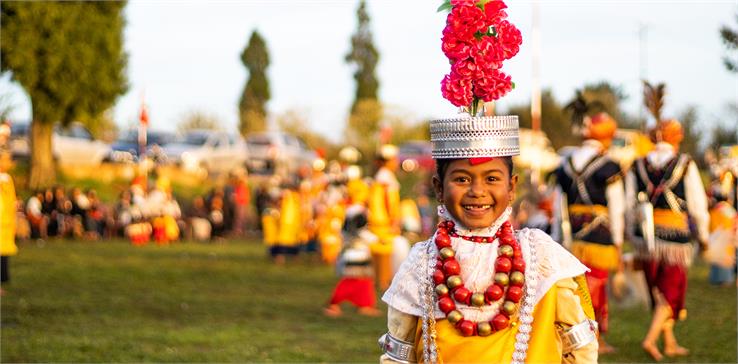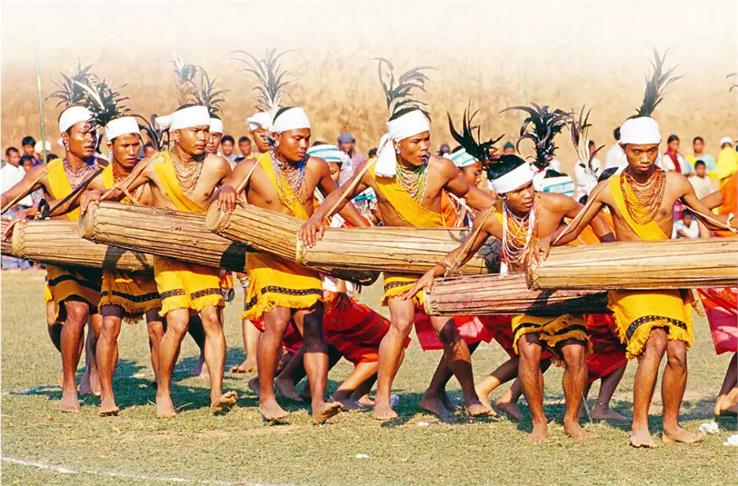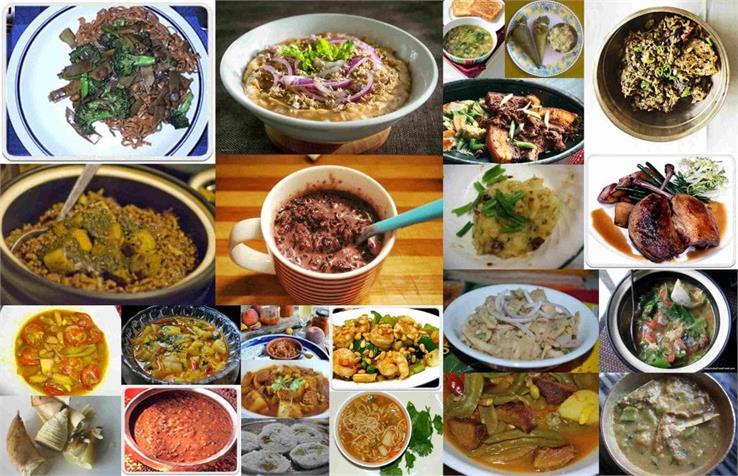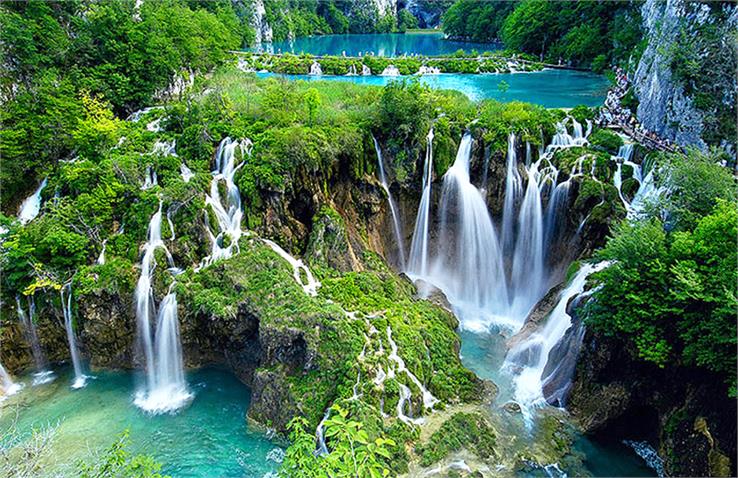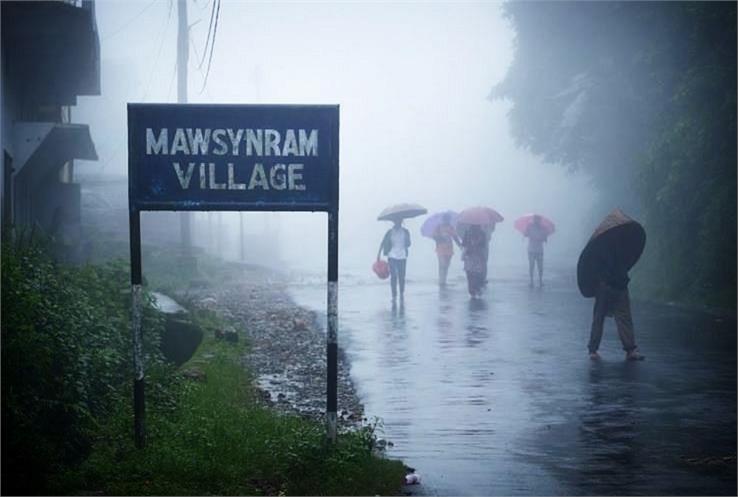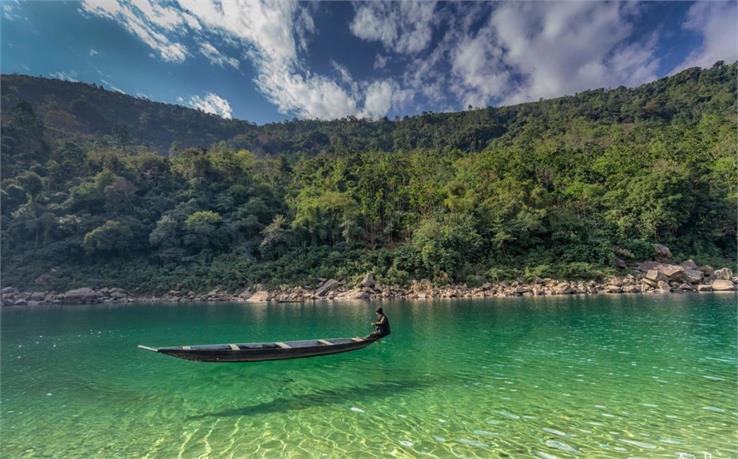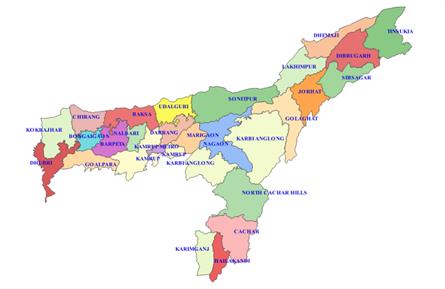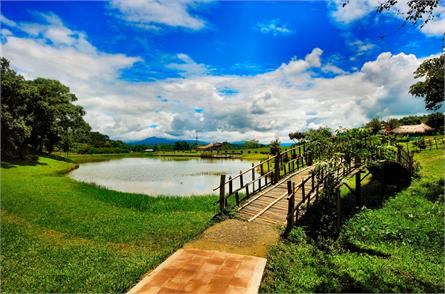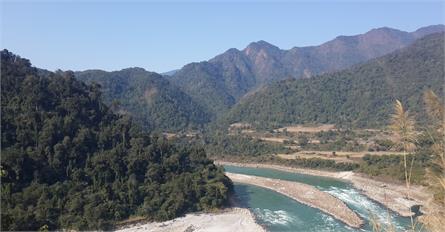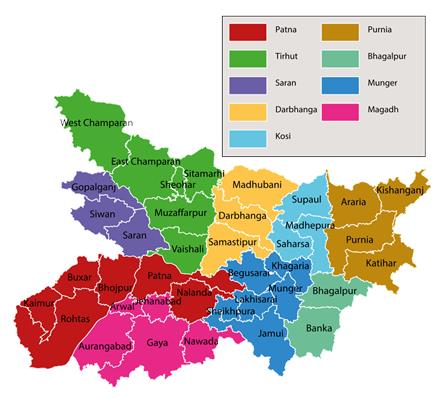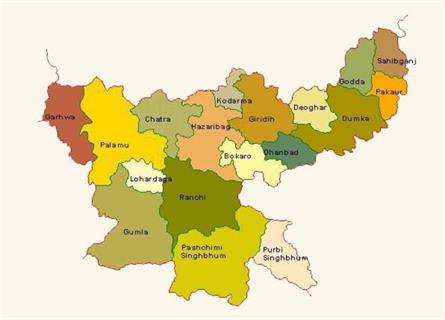Meghalaya - An Abode of Clouds
Meghalaya is a state in north-eastern India, which is surrounded by mountainous forest. Meghalaya, an attractive tourist destination, is quite famous for its beautiful mountain ranges, heavy rain, sunshine, high plateaus, breathtaking waterfalls, rivers, and grasslands. The plateau of Meghalaya is the center of attraction.
The literal meaning of the word Meghalaya is "abode of clouds." Shillong, the capital of Meghalaya, is a well-known tourist attraction, also known as a 'Scotland of the East.'
History
The history of Meghalaya is associated with the three major tribes living here, i.e., Khasi, Jaintia, and Garo. These people have lived here since ancient times. According to the legends, the Khasi were among the earliest tribes in the state. Around 1765, the region of Assam was occupied by the British. After independence in 1954, the residents of the region raised the demand for a separate state, which was rejected by the State Reorganization Commission.

Meghalaya was previously a part of the state of Assam, which was divided into a new province on 21 January 1972. The Act came into effect on 2 April 1970, and an autonomous state of Meghalaya was born out of Assam. Meghalaya attained the statehood on 21 January 1972, with a Legislative Assembly of its own.
Geography

Meghalaya is one of the Seven Sister States of northeast India. The total area of Meghalaya is about 22,720 sq km, with a population of 29,66,889. It is a mountainous state with valleys, plateaus, and hills. There are mainly Archaean rock formations in the state. These stone chains contain deposits of valuable minerals such as coal, limestone, uranium, and sillimanite. Meghalaya also has many rivers, most of which are rain-dependent and seasonal. The most peculiar aspect of the state is its rivers. Kalu, Ringgi, Simsang, and the Didak are the major rivers of the state flowing through the Garo Hills. On the other side, Khri, Umtrew, Digaru, Umiam or Barapani, Kynshi (Jadukata), Mawpa, Umiam Khwan, Umngot, Umkhen, Myntdu, and Myntang rivers are flowing through the central parts of the state.
Climate
The climate of Meghalaya is moderate but humid, also varies with altitude. It is neither too hot in summers nor excessively cold in winters. The weather is warm and humid over the plains of Garo hills. Annual rainfall is about 1200 cm in some areas. Mawsynram of Khasi Hills in Meghalaya has the title of the wettest place in India and the world. Mawsynram is located on the top of a hill amid a valley. The town of Sohra (Cherrapunji) holds the world record for maximum rain in a calendar month. The village named 'Mawsynram ' near the city Sohra also has a record of the highest annual rainfall. Forests cover One-third of the area of Meghalaya.
Demography
Meghalaya is dominantly a tribal state and populated by mainly three tribal communities, i.e., Khasis, Jaintias, and Garos. The tribes constitute 89% of the total population of Meghalaya. The Garo is the second largest group after the Khasi. Mikir, Lakhar, Boro, and Jaintia are the other groups found in the state. A recent census conducted by the concerned authorities revealed that a large number of Nepalese are also living in the state. A strong base of retired Indian soldiers living there can be seen in Shillong. It is an interesting fact that Meghalaya is one of the three states in India that has a population of about 70.3 percent of the Christian community.
Economy of Meghalaya
Meghalaya is one of the least developed states in India. Meghalaya has an agrarian state, as more than 80% of people are engaged in agriculture or allied activities. However, the sector contributes hardly one-third of the state's NSDP. Non-sustainable agrarian traditions are the major reason for low agricultural productivity in the state. For the same reasons, the state has to import food from other Indian states. Infrastructure constraints have kept the state's economy from generating that high-income jobs at a faster rate than the rest of India.
The 2012 gross state domestic product of Meghalaya was estimated at ₹ 16,173 crores (US$ 2.36 billion) at current prices. According to the Reserve Bank of India (2012), about 12% of the state's population was below the poverty line, out of which 12.5% in rural areas and 6.3% in urban areas.
Agriculture and Irrigation
About 80 percent of the population in Meghalaya is mainly dependent on agriculture. The soil and the climate of the state are favorable for gardening.
The main crops of the state are rice and maize, pineapple, bananas, papayas spices, etc. Cash crops include potato, turmeric, ginger, black pepper, betel nut, pan tapioca, short fiber cotton, jute and mesta, mustard and rapeseed. Currently, the focus is on the cultivation of oilseeds (peanuts, soybeans, and sunflowers), cashew, strawberry, tea and coffee, mushrooms, herbs, orchids, etc.
Industry
The state's financial and industrial development organization is named 'Meghalaya Industrial Development Corporation Limited,' which provides financial assistance to local entrepreneurs for the industry. The District Industrial Center is working for the development of rural and cottage industries. Several industries have also been set up for the production of iron, steel, cement, and other commodities.
Flora and Fauna
The state of Meghalaya is rich in flora and fauna. It has around 23 varieties of birds and wildlife species. Peacock, pheasant, and hoolock gibbon are found in the state of Meghalaya. About 70% of the state's area is forested, which includes dense subtropical forest. The forests of Meghalaya are also known as Asia's most prosperous botanical habitats. A small part of the forest of Meghalaya is also known as the 'sacred groves of India.' Nokrek Biosphere Reserve Park in Garo Hills and Balphakram National Park in South Garo Hills are known as the most beautiful parks in the state. The forest area exhibits a diversity of flowers, including many types of parasites, succulent plants, epiphytes, and shrubs. Shorea robusta (Sal Tree) and Tectona grandis (Teak) are the two important species of trees found in the state.
A large variety of mammals, birds, reptiles, and insects are found in the forests of Meghalaya. Apart from the mammals, bears, red pandas, elephants, civets, rodents, gaur, mongoose, vessels, wild buffalo, deer, wild boar, etc. also found in the state. Reptiles like lizards, crocodiles, and turtles are the major attractions here.
Education
Meghalaya is slowly but steadily gaining recognition as a technologically advanced state, while the state is not even a large part of India. According to the 2011 census, the total number of literate people living in the state is 74.43 percent. There are several junior, basic primary schools and secondary or higher-level educational schools in the state of Meghalaya. The state also has a polytechnic university and two teacher training colleges.
Media
Meghalaya has a strong presence in both electronic and print media. Many national and local newspapers and magazines are active in Meghalaya through print, news channels, and news portals.
Society and culture

The region is rich in tribal culture and folk tradition. Dance is an integral part of the social ceremonies and religious rituals of the state. Khasi, Garo, and Jaintia are the main tribes of Meghalaya. Marriage relationships are built outside their clan. The advent of Christianity in the mid-19th century and the strict morality associated with it have damaged many tribal and community institutions.
Most tribes of the state follow the matrilineal system. The rules of the traditional matrilineal system are followed by Khasi and Jaintia. The youngest daughter inherits the family property in the Goro dynasty system and is given the title 'Nokna,' which means 'for home.' However, if parents wish, they can make another daughter as heir.
Fair and Festivals of Meghalaya
The state of Meghalaya is believed to be home to dance and music. Celebrated throughout the year, the fair and festivals of the state are associated with their different dance forms. Each tribe has its own set of celebrations in which they actively participate to enhance the festive spirit and their monotonous lives. In fact, the indigenous festivals of this beautiful state reflect their varied heritage, especially during the festive season of sowing and harvesting. Most of the festivals in Meghalaya revolve around agriculture, which is the main occupation of the people. Although some religious and spiritual feelings are interwoven with secular rites and rituals, the pre-eminent theme of festivals is to offer prayers to the Supreme, known by different names in different Naga dialects. Major festivals of Meghalaya are as follow:

- Nongkrem Dance Festival: Nongkrem Dance Festival is one of the major festivals in the state of Meghalaya, which is a five-day festival held annually in November. The Nongkrem Dance Festival is celebrated as a harvest thanksgiving by the Khasi tribe. The festival begins with a goat sacrifice. The word Nongkrem means ‘goat killing ceremony.’
- Wangala - The Harvesting Festival: The Wangala Festival is a two-day festival celebrated in Meghalaya. It is the largest traditional festival for the Wangala Garo tribes, which is celebrated at the end of autumn and dedicated to Lord Sun. The harvest festival is organized in the second week of November every year. On the occasion of this festival, people like to dance day and night. The center of attraction of the Wangala Festival is 100 drums played by men in rhythm. Wangala Festival is popular as the 'Hundred Drums Wangala Festival.'
- Behdienkhlam Festival: The Behdienkhlam festival celebrated by the Jaintia tribe of Meghalaya. The Behdienkhlam festival is celebrated as the demon of chasing demons away and summoning good fortune. The festival of Meghalaya is celebrated every year on the occasion of sowing in July.
- Shad Suk Mynsiem: Shad Suk Mynsiem is a three days grand festival of the Khasi tribe. It is a thanksgiving ceremony celebrated during the spring season on the Khasi hills. Adorned with traditional beauty and attractive colorful costumes, men and women gracefully dressed up and participate in folk dances with great enthusiasm in the accompaniment of drum beats and other musical instruments.
- Doregata Dance Festival: This is a highly popular dance festival held in the state of Meghalaya. In this dance festival, female members try to tie the turban of their male counterparts.
Some other major festivals of Meghalaya include Pomelo Dance Festival, Shad Sukra, Strawberry Festival.
Traditional Attire of Meghalaya
The state of Meghalaya is well-known for its culture, rituals, and traditional dresses. There is a simplicity in the attire of the Meghalaya, which further enhances the beauty of this state. The traditional attire of the women of Meghalaya state is known as Jainsen. The clothes worn by them are made of silk without stitched mulberry and are wrapped around the body. Endi Shawl is one another prominent costume of the region, which is made of silk.
Attire worn by the Garo tribe of Meghalaya varies on the place of residence of the people. The women who live in the village wear eking, which is a small cloth worn around the waist and other women of the same tribes wear an outfit known as Dakmanda. On the other hand, the men of the Khasi tribe wear a long cloth around their waist, and loincloth (traditional dress) is worn by the men of the Garo tribe.
Languages
The language spoken by the people of Meghalaya includes three major languages, i.e., Garo, Khasi, and English. Khasi, the language spoken mainly by the people of Meghalaya, can be considered an Austro-Asian language. Khasi is an integral part of the Austro-Asian family. On the other hand, English is the official language of the state Meghalaya.
Good transport system
Meghalaya is a hilly state, located in the eastern sub-Himalayan hills. Meghalaya is one of the most beautiful landscapes in India, where nature has given many picturesque views. Smoke-covered hills and a never-ending series of clouds and forests covered with greenery will engulf your imagination. Due to which tourists are always motivated and ready to visit Meghalaya. The transport system of Meghalaya is also quite accessible.
By Air
The only airport is located in Umroi, 40 km away from Shillong on the Guwahati-Shillong highway.
By Road
The road network in the state is quite good. There is a network of roads all over the state. National Highway-40 is used in all weather, which passes through the state. The road, connecting Shillong to Guwahati, also connects other major cities of the country.
By Rail
There is no railway service in Meghalaya, but Guwahati is the nearest railway station. Road connectivity from Meghalaya to Guwahati is excellent. The weather does not obstruct this journey.
Shopping in Meghalaya
The entire northeastern region of India is recognized for its rich tradition of handicrafts, and Meghalaya is on top of the list. In other words, weaving is an integral part of the lives of the tribes in Meghalaya. These exquisite handicrafts of Meghalaya are famous all over the world.
As Meghalaya has a high forest area, So the tribes of Meghalaya have developed a heritage in woodwork. The tourist adores these woodwork handicrafts and creative items. Meghalaya cane woven mats and baskets are famous for their durability, while the floral designs make them more beautiful. The artwork is so impressive, and it is very difficult to choose one of the best. There are commercial plaza markets in Meghalaya, but local markets offer the best shopping experience in the state.
Some of the best items of Meghalaya are:
- Bamboo Handicrafts
- Cane and bamboo work
- Jewelry
- Shawls
- Scottish dress material
- Carpet and silk weaving
- Khasi scrub
- Handloom and Handicraft items
Famous Food of Meghalaya

When it comes to Indian cuisine, we often ignore the North East 'Cuisine'. If you visit these states, you will find the food and cuisine of the state are deeply connected to their traditions and culture, which are an essential part of the rich food variety of Indian cuisine. The state of Meghalaya is home to the Mongolian tribes including many different tasty dishes in their daily routine. The food and delicacies of Meghalaya are very different from the Northeast Indian states. Non-veg dishes are also very famous in the state. Here are a few lip-smacking dishes of Meghalaya:
Jadoh
Jadoh is a prevalent dish of the Khasi community of Meghalaya, whose beautiful color and fragrance will make anyone feel hungry. Jadoh is mainly red rice cooked with pork, chicken, or fish. Lots of spices are used to enhance the flavor. To make this delicious dish, a mixture of green chilies, onion, ginger, turmeric, black pepper, and bay leaves is made, followed by fried pieces of meat.
Dohneiiong
Dohneiiong is counted among the exclusive dishes of Meghalaya; people who love pork will love this dish. It is a pork curry. Fried pork is served with rice and thick gravy (made with green chili, black pepper, red onion, local spices, and black sesame). Black sesame is the main ingredient of the dish, which gives it a unique taste.
Nakham Bitchi
Nakham bitchi is a special soup made in the homes of Meghalaya, which is taken before meals. It is often served to guests. Nakham is a special type of dry fish, which is dried in the sunlight. To make the soup, it is first fried and then boiled in water. After boiling dry fish it is cooked with lots of chilli and black pepper to make it tasty. If you come to Meghalaya, then try the spicy soup here.
Minil Songa
It is a famous dish of the Garo tribes. It is a popular dish of the state, cooked with special rice called minil and green bamboo. The method of making this dish is also very unique. This lip-smacking dish is considered beneficial for the digestive system.
Pumaloi, Doh-Khlieh, Tungrymbai, Pudoh, Pukhlein, Sakin Gata are few other famous and delicious meals of Meghalaya.
Best time to Visit
Meghalaya is a beautiful state, where we can plan a trip anytime throughout the year. However, the best to visit Meghalaya is from October to March. The weather of the state is outstanding during these months.
Place to Visit
Meghalaya is a pretty famous tourist destination for its beautiful mountain ranges, heavy rainfall, sunshine, high plateaus, breathtaking waterfalls, rivers, and grasslands. Moreover, Meghalaya has many caves, mountain peaks, gardens, lake-resort sites, beautiful scenery, and hot water fountains. Most of the tropical forests are also found in Meghalaya. Birds, mammals, insects, and reptiles can be seen in the forests of the state. Some of the major tourist destinations of Meghalaya include:
Cherrapunji

Cherrapunji is an outstanding tourist destination in Meghalaya, which is known as the most magnificent place on earth. The site is excellent with its clean and pristine surroundings. The lush climate of Cherrapunji, its beauty, and the freshwater give a distinct feel of the surroundings. NohKalikai Falls, Thelen Falls, and Nohsngithiang Falls are famous among tourists to visit.
Mawsynram

Mawsynram is one of the most spectacular tourist destinations in the world. This place is like a paradise for rain lovers and nature lovers. Mawsynram and Cherrapunji are close to each other. The meaning of Mawsynram is derived from the Khasi word "Mav" which means stone. The size of this village is similar to that of Sivalingam and the village is known for collecting stalagmites.
Shillong
Shillong, the capital city of Meghalaya, is listed among the major tourist destinations of the state. 'Shillong is also known as the Scotland of the East' due to its attractive hills. It is the first such hill station of India that can be reached from all four sides.
Mawlynnong
Mawlynnong village remains a center of tourist attraction in Meghalaya, which is also known as 'God's own garden.' The village achieved the title of being the cleanest village in Asia in 2003. The people of this village mostly use English for conversation.
Dawki

Dawki Lake is an attractive spot to explore in Meghalaya and is a major center of trade between India and Bangladesh. The cold water of the river and the beautiful suspension bridge make Dawki a worth-seeing place in Meghalaya.
Meghalaya, an abode of clouds, is a place full of adventure and various spots. Kyllang Rock, Nohsngithiang Falls, Balphakram National Park, Khasi Hills, Lady Hydari Park, Double Decker Living Root Bridge, Don Bosco Museum, Umiam Lake, West Jaintia Hills are few more places to visit in the state.


